 |
Convert MOV to JPG/JPEG Sequence
|
JPG/JPEG is a commonly used method of lossy compression
for digital photography (image). The degree of compression can be adjusted, allowing
a selectable tradeoff between storage size and image quality. JPEG typically achieves
10:1 compression with little perceptible loss in image quality.
MOV to JPG/JPEG Converter Software converts MOV to JPG/JPEG
sequence files. So, you could get every frame image of MOV in
JPG/JPEG format. You can also set output frame rate and JPG/JPEG resolution in
the software. The output JPG/JPEG files look something like the following screen
shot.
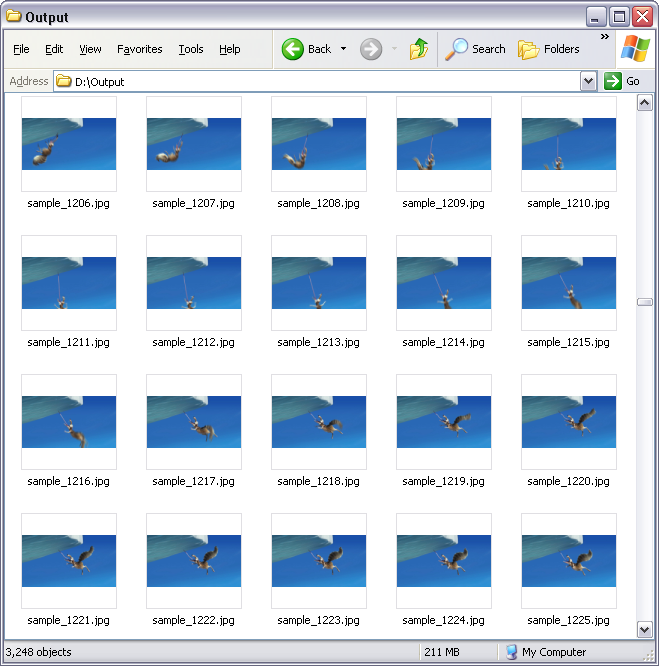
The software also supports other formats and portable devices such as CAF (Core Audio Format), Windows Phone, MKV, WebM (VP8), M4V, AU, MP2,
etc. The software could convert FLV to M4A (MPEG-4 audio), WMV to SPX (Speex), 3G2 to DivX, 3GP to AMR, DAT to MKV, and so on.
MOV to JPG/JPEG Software supports batch conversion and, is compatible
with Windows 10/8/7/Vista/XP/2000.

What is MOV?
Video files encoded in the MOV file format are in a proprietary format
developed by Apple. MOV files are used by Apple Quicktime player, which
is a specific video player for Apple. So, if you have a video on an IPOD
type device that ends in ".mov", or if you have such a file on
your computer, it may not be compatible with other types of players, especially
simpler ones. In order to use a MOV file in a player that needs a more
compatible format such as MPEG, you must do a conversion. QuickTime movie
files, which have the file extension .mov, are among the primary video
files that work with Apple's iMovie. The iMovie video-editing software
comes standard with Apple computers. Importing a movie file into the application
and editing it by cutting, pasting and adjusting the audio/video are all
simple processes. You can then take the edited movie and save it in a new
file, be it in .mov or some other format. Quicktime is a multimedia development,
storage, and playback technology from Apple. MOV files are played on a
QuickTime Video player. QuickTime player is a free media player developed
by Apple and is available for Windows and Mac OS X systems. This easy-to-use
player allows you to play your MOV files of different sizes and aspect
ratios at high resolutions. Watch your standard or high-definition MOV
files in the best way possible. Open and view the .mov file using the default
media player installed on your system. The regular (and free) version of
Quicktime allows you to play these files from any source--you can play
files on your hard drive or ones embedded into web pages on the Internet.
Other media programs and digital devices, including Windows Media Player
and many digital cameras, also use the format to store video files.
What is JPG?
Short for Joint Photographic Experts Group, and pronounced jay-peg. JPEG
is a lossy compression technique for color images. Although it can reduce
files sizes to about 5% of their normal size, some detail is lost in the
compression. JPEG images are commonly used for Web graphics and for storing
photos taken with digital cameras. They are usually saved with a .JPG extension.
JPEG standards are formally named as Information technology - Digital compression
and coding of continuous-tone still images. Motion JPEG 2000 (often referenced
as MJ2 or MJP2) also is under consideration as a digital archival format
by the Library of Congress. It is an open ISO standard and an advanced
update to MJPEG (or MJ), which was based on the legacy JPEG format. Unlike
common video formats, such as MPEG-4 Part 2, WMV, and H.264, MJ2 does not
employ temporal or inter-frame compression. Instead, each frame is an independent
entity encoded by either a lossy or lossless variant of JPEG 2000. Its
physical structure does not depend on time ordering, but it does employ
a separate profile to complement the data. For audio, it supports LPCM
encoding, as well as various MPEG-4 variants, as "raw" or complement
data. Within the entropy-coded data, after any 0xFF byte, a 0x00 byte is
inserted by the encoder before the next byte, so that there does not appear
to be a marker where none is intended, preventing framing errors. Decoders
must skip this 0x00 byte. This technique, called byte stuffing, is only
applied to the entropy-coded data, not to marker payload data. Note however
that entropy-coded data has a few markers of its own; specifically the
Reset markers (0xD0 through 0xD7), which are used to isolate independent
chunks of entropy-coded data to allow parallel decoding, and encoders are
free to insert these Reset markers at regular intervals (although not all
encoders do this).
How to Convert MOV to JPG/JPEG Sequence?
- Free Download MOV to JPG/JPEG
Converter Software
- Install the Program by Step-by-step Instructions
- Launch MOV to JPG/JPEG Software
- Choose MOV Files

Click "Add Files" to choose MOV files.

Choose one or more MOV files you want to convert and then click Open.
MOV to JPG/JPEG Software will open MOV files and get file information
of the file such as width, height, frame rate, video bit rate, audio sample rate,
audio bit rate, audio channels, and then display the information of MOV file
at conversion list.
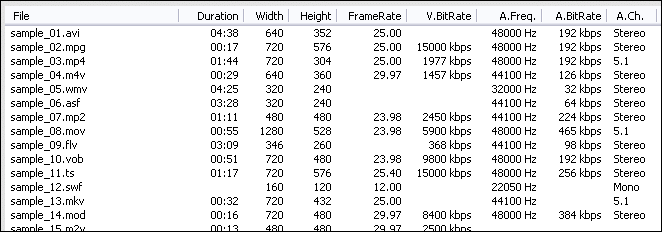
- Choose Output Format
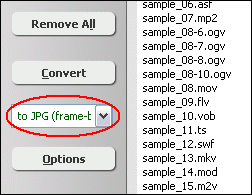
Click on combo-box of output format and then choose "to JPG (image sequence)".
- [Optional, for advanced user]
Set JPG Encoding Parameters
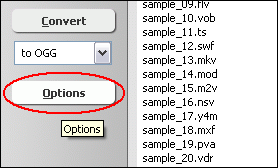
If you want to change JPG encoding parameters such as frame rate, video size,
aspect ratio, and so on, please click "Options".

And then, switch to tab "Video & Audio" and choose "JPG
(image sequence)" at "Output Format", and then set options
for image encoding.
- Convert MOV to JPG/JPEG
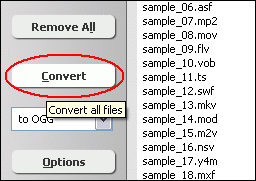
Click "Convert" to convert MOV to JPG/JPEG sequence.

The software is converting MOV files to JPG/JPEG.
- View and Browse JPG/JPEG Files
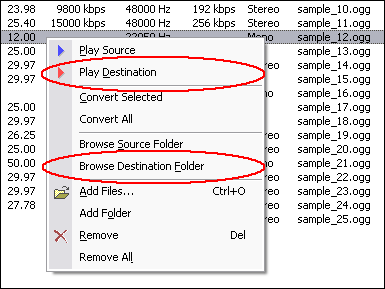
When conversion completes, you can right-click converted item and choose "Play
Destination" to view the first outputted JPG file; or choose "Browse
Destination Folder" to open Windows Explorer to browse the outputted JPG
files.
- Done
Top
MOV to JPG/JPEG Software is 100% clean and safe to
install. It's certified by major download sites.

Convert MOV to JPG/JPEG Related Topics:
|












